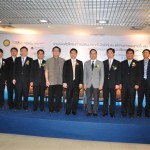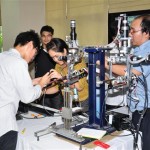Thailand is positioning itself as an Asean regional hub for the advanced medical robot industry.
The government has asked the Ministry of Science and Technology to develop medical robot technology under a 2-billion-baht budget, based on a five-year plan from this year to 2017.
The ministry has invited its allies in the sector _ Thailand Centre of Excellence for Life Science (TCELS), National Nanotechnology Centre, Synchrotron Light Research Institute , state-owned universities and private sector_ to join the project.
The project includes developing protocols for robot development, a marketing plan for luring international investors and production of medical robots for sale at a reasonable price, Weerapong Pairsuwan, the ministry’s permanent secretary said.
Mr Weerapong said the ministry needs about 2 billion baht for the project. He said an advanced medical robot services development centre would be needed at Mahidol University to study technology transfer and conduct research and development into medical robotic sciences.
The ministry will begin the next phase of the project after that, by choosing some robotic prototypes. It will ask private firms to produce them for sale.
“If everything goes to plan, we can look forward to the success of the project in 2017 as we will be able to reduce imports of advanced medical robots by half,” he said. “Moreover, we can turn ourselves into a regional base for advanced medical robot production.”Thailand spends 780 million baht on advanced medical robots each year, a bill which is only likely to increase as a result of higher demand for more sophisticated treatment in the medical sector, and as the population ages.
Nares Damrongchai, director of TCELS, said he would focus on a prototype of robot that can diagnose cancer. Mr Nares said Siriraj Hospital had employed robotic technologies for six years. Prof. Sirirurg Songsivilai, Executive Director of NANOTEC added that his researchers are already working on nanotechnology related project pertaining to cancer cell detection such as cervical cancer. NANOTEC is in a position to contribute to this important project.
Doctors conduct operations through a three-dimensional screen. The robot moves into the patient’s body with the same speed and direction as the doctor operating it.
Robots have been employed in about 1,400 cases. Meanwhile, Chulalongkorn University’s faculty of medicine is now using a robot to cultivate stem cells, replacing human labour for the mass production of stem cells.
A report last year put the value of the robot industry worldwide at about US$8.5 billion (249 billion baht).

